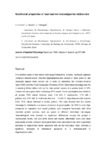Nutritional properties of four marine microalgae for albino rats

View/
Use this link to cite
http://hdl.handle.net/2183/13944Collections
- Investigación (FCIE) [1227]
Metadata
Show full item recordTitle
Nutritional properties of four marine microalgae for albino ratsDate
1993-12Citation
Herrero C, Abalde J, Fabregas J. Nutritional properties of four marine microalgae for albino rats. J Appl Phycol. 1993;5(6):573-80
Abstract
The nutritive value of the marine microalgaeTetraselmis suecica, Isochrysis galbana, Dunaliella tertiolecta and Chlorella stigmatophora was studied in diets given to rats. Biological assays were carried out in order to determine the Protein Efficiency Ratio (PER) and the Food Conversion Efficiency (FCE). Each dried microalga was fed to weaning Wistar albino rats as the sole protein source at a protein level of 12%. Control rats were given diets containing 12 % casein. Food consumption was similar in all groups. PER values obtained were 1.14 with T. suecica diet, 1.13 with I. galbana diet, 2.07 with D. tertiolecta diet and 1.13 with C. stigmatophora diet (casein, 2.50). FCE values followed a similar pattern. The data showed that the marine microalga D. tertiolecta is a source of protein of good quality. Its PER is quite high, compared to vegetable and cereal proteins, and compares favourably with other microbial protein sources, such as yeasts or different freshwater microalgae. Haematological tests showed no significant differences among the groups in haemoglobin levels, red and white blood cell counts, differential count and mean corpuscular volume. Different blood parameters were also determined and a significant decrease in triglycerides levels appeared with all the microalgal diets, whereas a significant decrease in cholesterol appeared in D. tertiolecta and C. stigmatophora diets.
Keywords
Food Conversion Efficiency (FCE)
Albino rats
Nutritive value
Marine microalgae
Tetraselmis suecica
Isochrysis galbana
Dunaliella tertiolecta
Chlorella stigmatophora
Protein Efficiency Ratio (PER)
Albino rats
Nutritive value
Marine microalgae
Tetraselmis suecica
Isochrysis galbana
Dunaliella tertiolecta
Chlorella stigmatophora
Protein Efficiency Ratio (PER)
Editor version
Rights
The final publication is available at link.springer.com





